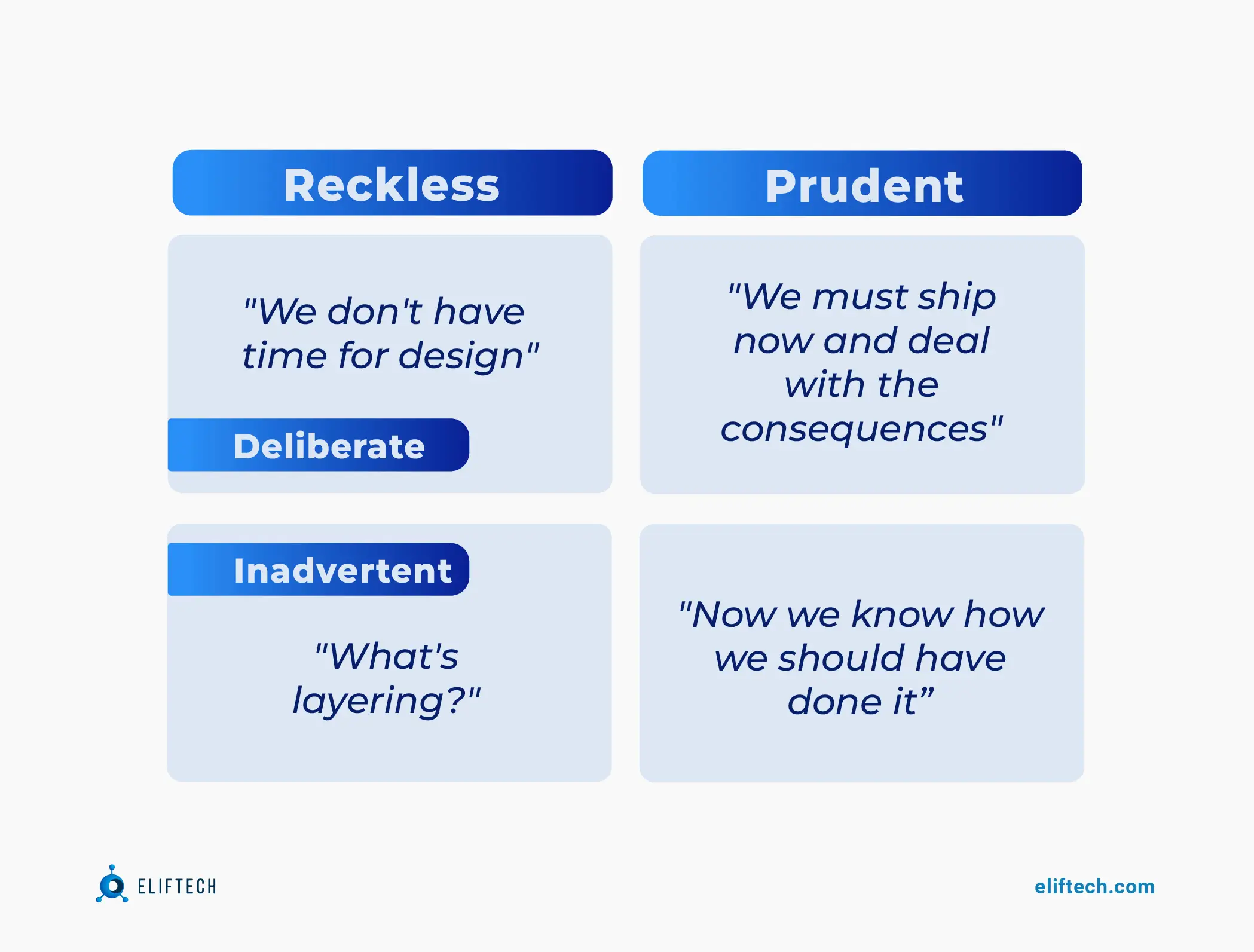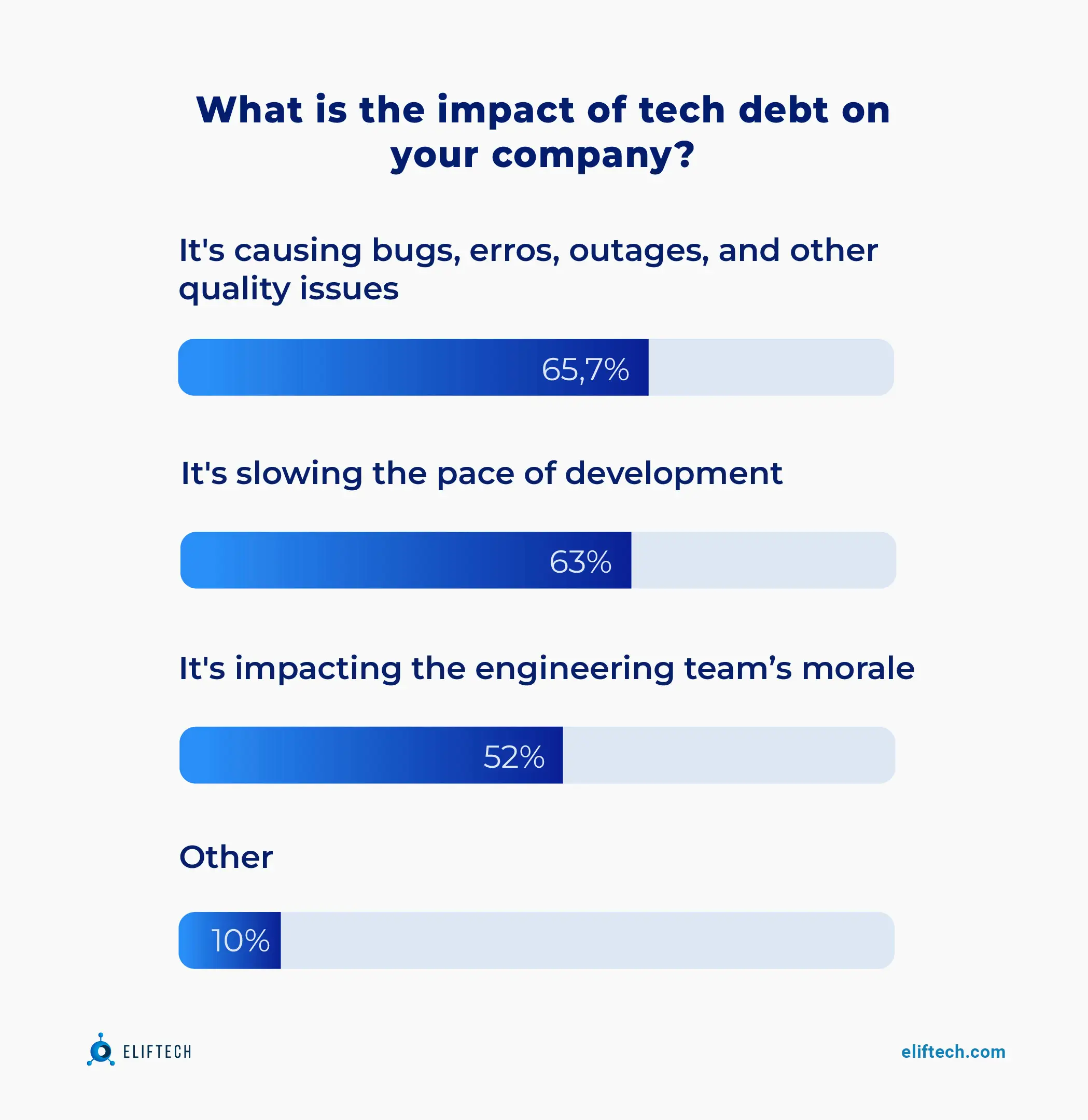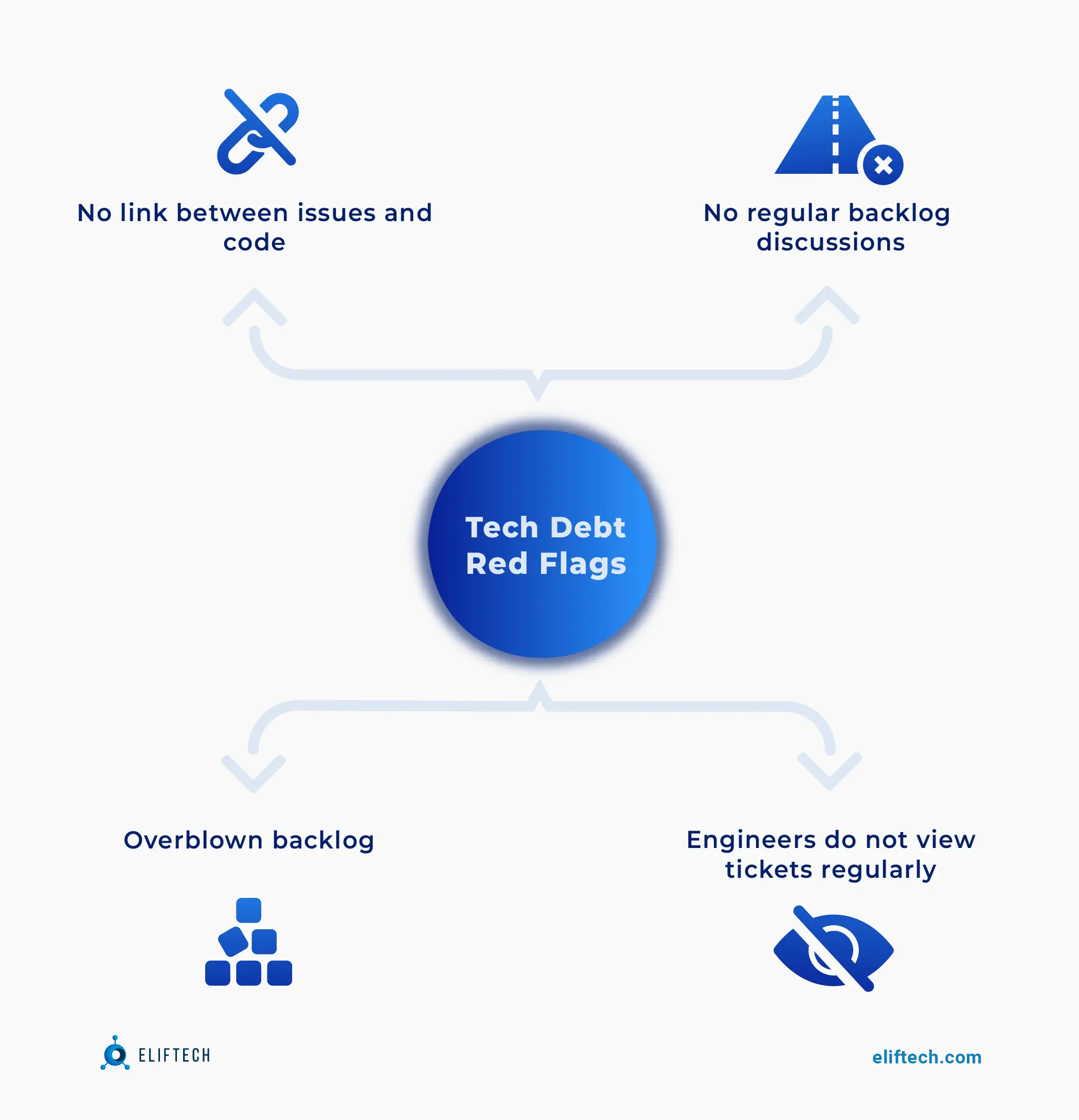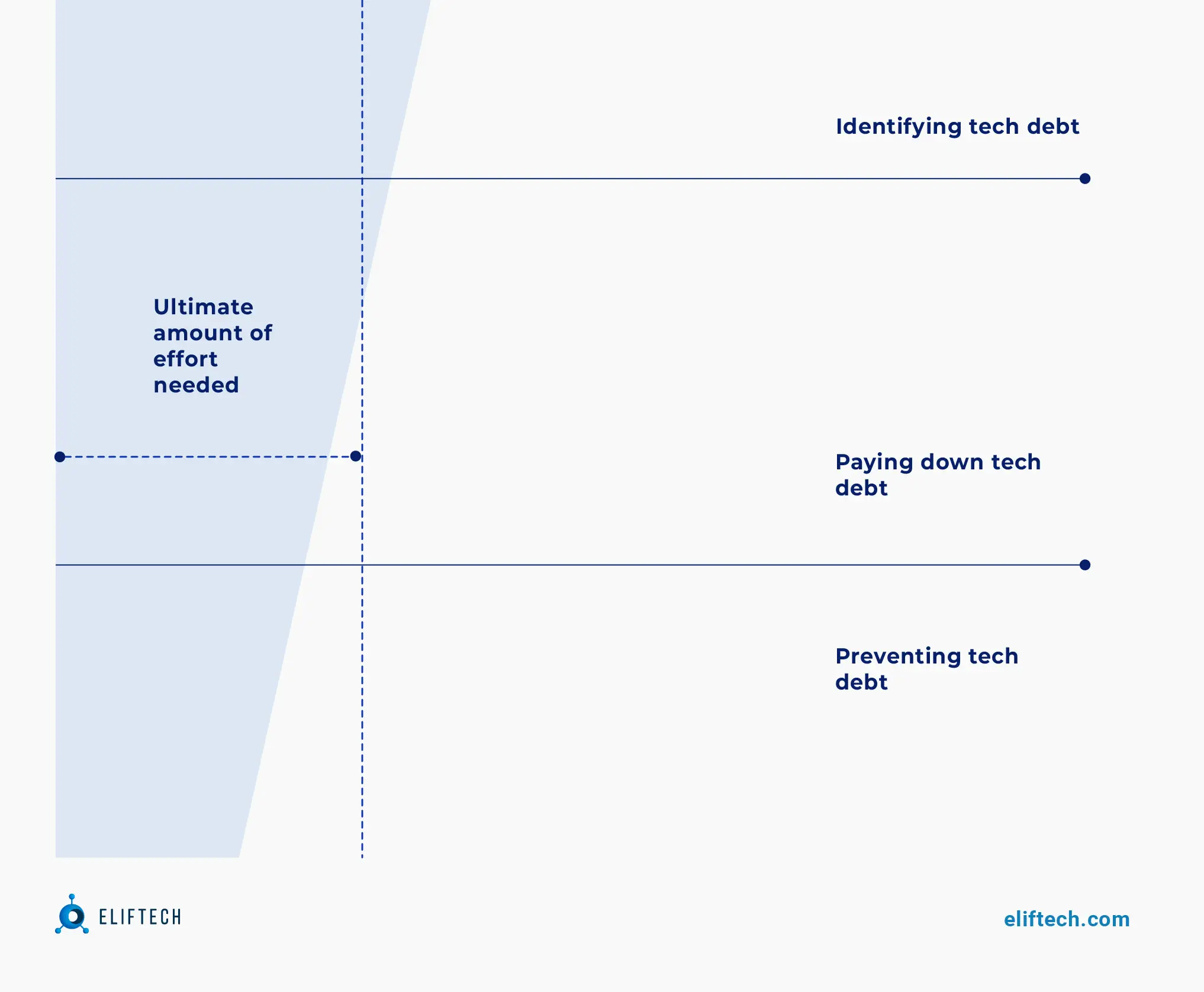Outsourcing
Types of Technical Debt: How to Prioritize and Reduce It

Technical debt is now viewed as somewhat of a mysterious demonic entity to combat – a view propagated mostly by business-oriented stakeholders at a given company. At the same time, technology often requires producing tech debt as a strategy to deliver what must be delivered at the time it must be delivered. Tech debt can become crippling when not addressed properly, or when incurred recklessly. In this article, we delve into what are the types of technical debt, how to prioritize tech debt, and show some of the best practices in handling tech debt based on our extensive expertise.
What is Technical Debt, Anyway?
First of all, technical debt is a notion that needs to be demystified (no, it’s not inherently bad, it’s not the Voldemort to your Company Who Lived). At its core, technical debt merely refers to the accumulated compromises and shortcuts made during the development process that can lead to future challenges. For example, when the market is ripe with need, it’s often better to release a product that the customers can already use (and pay for) – but one that needs readjustments so that you (i.e. the company) don’t pay for that convenience. There may be inconvenient maintenance options, cumbersome code, clutch-like integrations, or patches – but it’s better for everyone to have a functional product early on.
Imagine it as a loan – a quick fix or workaround implemented to meet tight deadlines, but with the understanding that it will need to be repaid with interest in the form of additional work and potential complications down the line.
Technical debt is a natural part of the custom software development lifecycle, but it requires a balanced approach. Recognizing when to take on technical debt consciously, and when to invest time in addressing it, is crucial for maintaining a healthy codebase and ensuring long-term success in software projects. By understanding the origins of the term and its implications, developers can make informed decisions to strike the right balance between delivering solutions quickly and building sustainable, maintainable software.
Types of Technical Debt
Martin Fowler, a respected software developer and author, introduced the concept of the "Technical Debt Quadrant" to categorize the two primary dimensions of technical debt: intentional vs. non-intentional and reckless vs. prudent.
1. Reckless and Prudent Debt: This quadrant encompasses the technical debt that accrues unknowingly due to hasty decision-making or lack of awareness. It represents the unforeseen consequences of shortcuts taken without a deliberate strategy.
2. Deliberate and Unintended Debt: On the opposite end, this quadrant recognizes situations where technical debt is a conscious choice made with a clear understanding of the trade-offs.

Sometimes, businesses and developers intentionally take on debt to meet tight deadlines, gain quick wins, or experiment with a concept before committing extensive resources.
Of course, once you delve into what exactly the debt is and where it lies, the classification will be instead based on the particular areas of software development. In this respect, technical debt can be viewed as:
- Architecture Debt: Relates to compromises made in the overall structure of a system, leading to challenges in scalability, performance, or future enhancements.
- Build Debt: Arises from shortcomings in the build and deployment processes, hindering the efficiency and reliability of software delivery pipelines.
- Code Debt: Involves shortcuts taken within the codebase, leading to suboptimal or inefficient solutions that may require refactoring in the future.
- Defect Debt: Results from delaying the resolution of bugs or issues, potentially causing more significant problems over time.
- Design Debt: Pertains to compromises in the overall design of a system, impacting its maintainability, extensibility, and overall quality.
- Documentation Debt: Occurs when documentation is neglected or becomes outdated, making it challenging for developers to understand and maintain the system.
- Infrastructure Debt: Involves shortcomings in the underlying infrastructure, such as outdated servers or dependencies, affecting the system's stability.
- People Debt: Arises from challenges in team dynamics, communication, or skill gaps, impacting the overall productivity and effectiveness of the development team.
- Process Debt: Relates to deficiencies in development processes, such as inadequate testing procedures or suboptimal project management practices.
- Requirement Debt: Emerges when essential requirements are not adequately defined or are subject to frequent changes, leading to scope creep and project delays.
- Service Debt: Involves compromises in the design or implementation of services, affecting the overall reliability and performance of distributed systems.
- Test Automation Debt: Occurs when automated testing processes are neglected or become outdated, compromising the efficiency of software testing.
Examples of Tech Debt
Technical debt is a multifaceted phenomenon, and its relevance is different depending on the industry the app, or other software product, is working with. To illustrate the point and main types of technical debt, let’s consider three hypothetical scenarios, each with a different industry:
Financial Technology (FinTech) Company: Accelerated Feature Release Compromises Data Security
Say there’s a leading FinTech company known for its swift innovation in financial transactions, and they’re eager to roll out new features, which has led to the accumulation of technical debt in the realm of data security. Quick turnarounds and tight deadlines have prompted the development team to implement temporary solutions or bypass stringent security protocols, creating potential vulnerabilities in the platform's defense against cyber threats. While in the first months after the release, the risks were not that high, they are aggregated each week once the user community grows. Addressing this debt is critical to maintaining user trust and upholding regulatory compliance.
Healthcare Organization: Aging Electronic Health Record (EHR) System Hinders Adaptability
A prominent healthcare organization committed to providing top-notch patient care is using an aging Electronic Health Record (EHR) system. As the organization expanded and faced evolving healthcare regulations, its venerable track record and age turned against it, and the existing EHR system struggled to adapt. Add to that the executives’ reluctance to invest time and resources in a comprehensive system upgrade – and there it is, technical debt. Over time, this debt presented challenges in integrating new technologies, diminished system performance, and posed potential risks to patient data security.
Educational Technology (EdTech) Startup: Scaling Challenges in LMS Development
In a dynamic EdTech startup recognized for pioneering learning solutions, technical debt may have surfaced in the development of a Learning Management System (LMS) with limited scalability. Focused on rapid feature deployment to attract a growing user base, the startup may have chosen quick and straightforward solutions that struggle to scale with the increasing demand. This could result in performance bottlenecks, occasional downtimes, and difficulties in delivering a seamless learning experience as the user base expands. Recognizing and addressing this technical debt is pivotal for the EdTech startup to sustain its rapid growth, uphold user satisfaction, and adapt to the evolving landscape of educational technology.
Why is Technical Debt Important?
Technical debt, the way it’s supposed to be, is not a demon to combat. It is rather a kind of compromise made in the development process when choosing a quick and expedient solution over a more comprehensive, but time-consuming one. This shortcut can manifest as code that may not be optimal, postponed refactoring, or a temporary fix to meet a tight deadline.
While these decisions may accumulate and lead to long-term consequences, there are situations where technical debt is an intentional and acceptable trade-off:
- Rapid Prototyping and Time-to-Market: Getting a product to market quickly is often crucial. Embracing a certain amount of technical debt during the prototyping phase allows teams to validate concepts, gather feedback, and make informed decisions before committing to a more refined, but time-consuming, implementation.
- Resource Constraints: Teams might face limitations in terms of budget, manpower, or other resources. In such cases, taking on manageable technical debt can be a strategic choice to meet immediate goals while planning to address the debt in future iterations.
- Changing Requirements: Agile development methodologies acknowledge that requirements can evolve over time. In the face of uncertainty, developers may opt for solutions that cater to the current needs, postponing the optimization of code until the requirements stabilize.
- Emerging Technologies: In dynamic industries like logistics, edtech, or fintech, where technologies are rapidly evolving, choosing to incur technical debt allows developers to adapt quickly to emerging trends. This flexibility can be crucial to staying competitive in markets where innovation is paramount.
It is easy to see why technical debt is something of a boogeyman, though. Technical debt is notably burdensome, increasing project costs by 10-20%. This is due to shortcuts over sustainable solutions, which lead to more time and resources spent in the long run. CIOs estimate that technical debt makes up 20-40% of their technology estate's value before depreciation, highlighting its pervasive effect on an organization's technology infrastructure.
The effects of mismanaged technical debt ripple through an organization, causing project delays, higher maintenance efforts, and slower development. This not only undermines a company's competitive edge and innovation but also affects its responsiveness to market shifts.
Accumulated technical debt, while initially lending agility to the development process, can evolve into a cumbersome, inefficient cycle. As this debt builds up, it hampers teams' ability to adapt to new technologies, meet changing customer needs, and maintain a competitive edge.

To recap:
- Accumulated technical debt can impact development timelines by introducing recurrent bugs and compromising system performance.
- Elevated levels of technical debt may rigidify a system, constraining the integration of new features and triggering scalability challenges.
- Tackling technical debt requires the allocation of resources and time, potentially hindering overall productivity and escalating maintenance costs.
- The ongoing presence of technical debt has the potential to contribute to developer burnout as teams grapple with continuous bug-fixing efforts.
Identifying and Tracking Technical Debt
So if you’ve been working with software for more than a year, chances are, you do have some types of technical debt. And that means you should do something about it ASAP. A startling statistic emphasizes this urgency: a significant 15% of developers believe that implementing a structured process for managing technical debt could potentially boost their productivity by a staggering 200%.
Effectively managing technical debt begins with accurate identification. Development teams need to cultivate a keen awareness of the various forms technical debt can take, from suboptimal code structures to postponed refactorings and expedient solutions. Regular code reviews, automated tools, and continuous communication within the team can serve as invaluable aids in identifying potential debt.

Once identified, tracking technical debt becomes paramount. This involves creating a systematic approach to record, prioritize, and monitor instances of technical debt. Utilizing project management tools, issue trackers, or dedicated platforms can provide a centralized repository for documenting and managing technical debt. By assigning priorities and categorizing debts based on their impact, development teams can make informed decisions about when and how to address each instance.
Paying Down the Technical Debt
Addressing technical debt is a crucial aspect of maintaining a healthy and sustainable codebase. Failing to do so not only impacts development timelines but also incurs additional costs. A revealing statistic highlights this financial aspect, indicating that technical debt adds an extra 20% to 30% to the overall cost of any development project. To mitigate these consequences and foster a culture of proactive debt management, here are some best practices for "paying down" technical debt:
- Regular Code Reviews
Implementing routine code reviews helps identify and rectify potential sources of technical debt early in the development process. This collaborative approach ensures that code is not only functional but also aligns with established coding standards. - Automated Code Analysis Tools
Leverage automated tools to conduct static code analysis, identifying areas of the codebase that may require attention. These tools can help catch common issues and enforce coding guidelines, reducing the likelihood of technical debt accumulation. - Incremental Refactoring
Instead of deferring refactoring indefinitely, adopt an incremental approach. Prioritize and tackle smaller refactoring tasks regularly to prevent the buildup of significant technical debt over time. - Documentation and Knowledge Sharing
Maintain thorough documentation to facilitate knowledge transfer within the team. A well-documented codebase ensures that developers are aware of potential pitfalls and can make informed decisions to avoid introducing technical debt. - Test-Driven Development (TDD)
Embrace Test-Driven Development as a proactive measure to catch potential issues early in the development cycle. This approach not only ensures the reliability of the codebase but also reduces the likelihood of introducing technical debt.
Communicating Technical Debt to Non-technical Stakeholders
This may all seem good and well, but another problem is that the non-tech decision-makers in a company may feel reluctant to invest in addressing tech debt. After all, there’s an MVP already circulating across the market, and it’s more exciting and urgent to expand upon it (then marketing can say something, etc.) However, effectively communicating the need to address different types of technical debt to stakeholders without a technology background is essential for garnering support.

Here are some key points to convey:
1. Emphasize Impact on Quality
Describe how addressing technical debt directly contributes to the overall quality and reliability of the software. Emphasize that proactive debt management leads to more robust and maintainable systems.
2. Highlight Cost Implications
Clearly articulate that neglecting technical debt adds an additional 20% to 30% to the overall cost of development projects. This cost is not just financial but also encompasses potential delays and increased maintenance efforts.
3. Illustrate Long-Term Benefits
Communicate the long-term benefits of investing in technical debt reduction, such as improved agility, faster response to market changes, and a more sustainable and competitive product.
4. Use Analogies and Real-World Scenarios
Draw parallels between technical debt in software development and relatable real-world scenarios. Analogies can help non-technical stakeholders grasp the concept and understand the importance of addressing it in a timely manner.
Preventing Excessive Technical Debt
A significant 52% of engineers acknowledge that different types of technical debt adversely affects their team's morale. To foster a positive and productive work environment, it's essential to proactively prevent the accumulation of excessive technical debt. Here are key strategies to mitigate technical debt and uplift team morale:
Cultivate a Culture of Quality: Instill a culture where code quality is valued over quick fixes. Encourage team members to take pride in crafting well-structured, maintainable code. Prioritize education on best practices and emphasize the long-term benefits of quality code.
Prioritize Technical Debt in Planning: Integrate the consideration of technical debt into project planning and decision-making processes. Allocate time and resources for addressing technical debt alongside new feature development. Treating technical debt as an integral part of the development lifecycle prevents its unchecked growth.
Regular Refactoring Sprints: Dedicate specific sprints or cycles for refactoring and debt reduction. By allocating focused time for addressing technical debt, teams can make substantial progress without compromising ongoing development efforts. This approach helps prevent technical debt from becoming an overwhelming burden.
Continuous Learning and Skill Development: Foster an environment that encourages continuous learning and skill development. Technical debt often arises from gaps in knowledge or the use of outdated practices. By investing in the professional growth of team members, you equip them with the tools to write cleaner, more efficient code.
Implement Code Quality Metrics: Integrate code quality metrics into your development process. Utilize tools that provide insights into code maintainability, complexity, and adherence to coding standards. Regularly assess these metrics to identify areas of concern and guide proactive debt reduction efforts.
Conclusion
In the realm of software or custom web development, the management of technical debt stands as a critical determinant of a project's success and an organization's long-term viability. As we've explored the intricacies of technical debt, from its varying forms to its profound impact on productivity, quality, and team morale, it's evident that a proactive approach is essential.
The statistics paint a compelling picture: technical debt adds significant percentages to project costs, impacts team morale, and poses a genuine threat to the longevity of software systems. However, it's not a challenge without solutions. By embracing best practices in identifying, tracking, and paying down technical debt, development teams can foster a culture of continuous improvement.
At ElifTech, we understand the nuanced landscape of technical debt and stand ready to assist organizations in navigating these challenges. Our seasoned experts bring a wealth of experience in assessing, managing, and mitigating technical debt, ensuring that your software projects not only meet immediate goals but are poised for sustained success.
If you find your team grappling with the complexities of technical debt or are simply looking to proactively manage your codebase for enhanced efficiency and longevity, we invite you to reach out. Our tailored solutions and collaborative approach empower organizations to address technical debt systematically, striking the delicate balance between innovation and sustainability.
